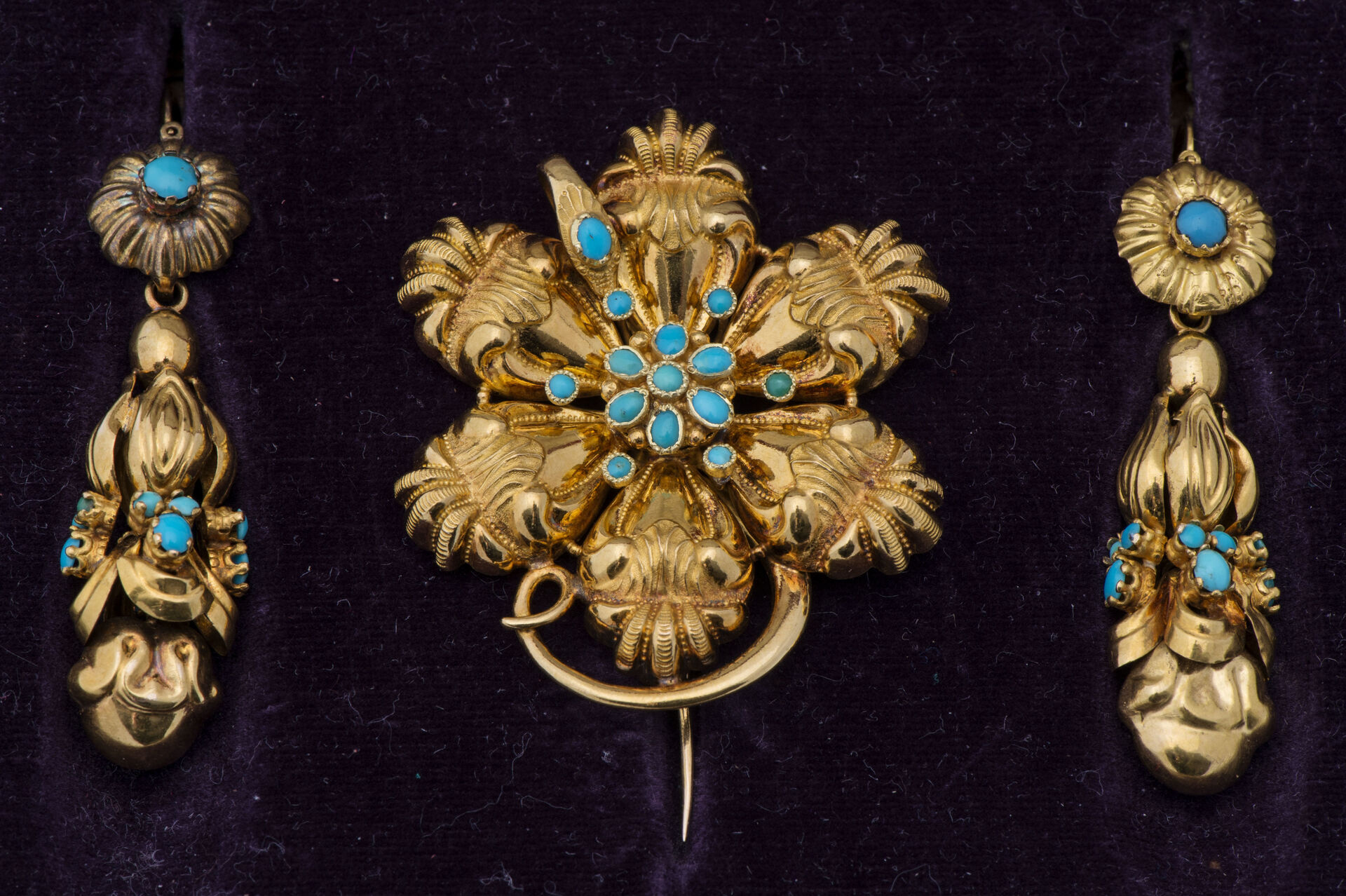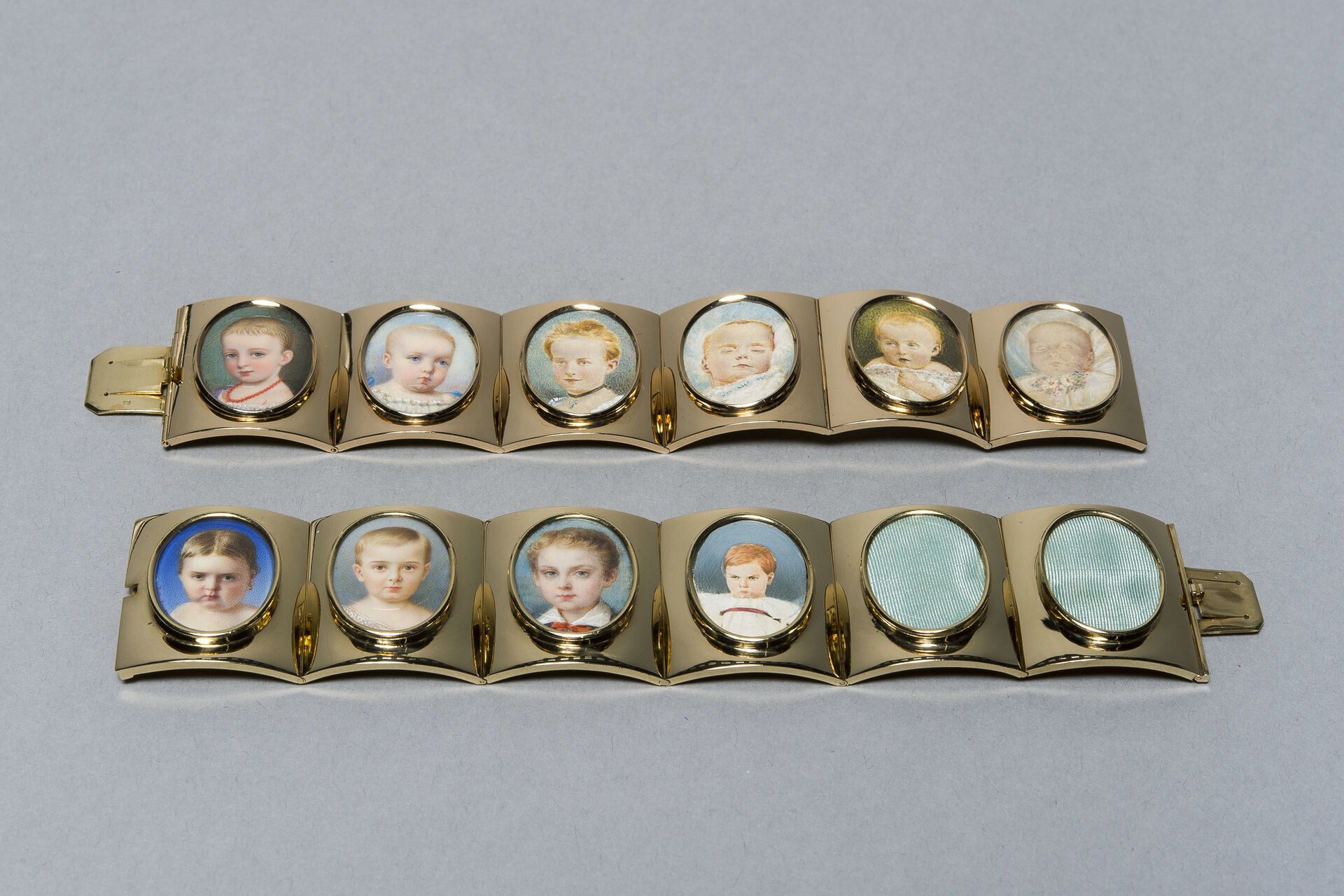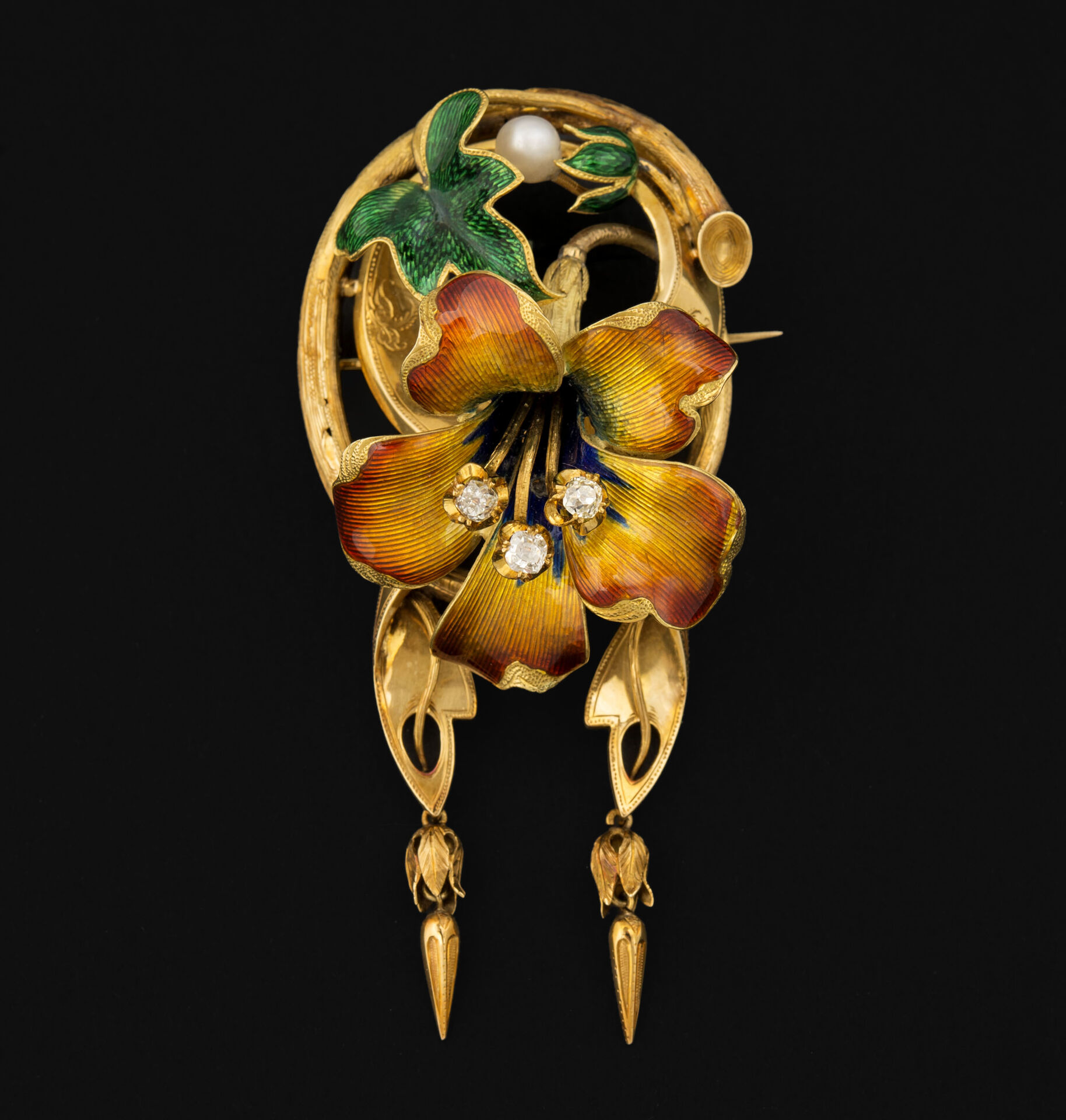Acquisitions of Old Jewellery
For many years, jewellery, and especially old jewellery, was one of the least-known of the Nationalmuseum’s special collections. Modern and contemporary objects, on the other hand, had been acquired systematically and extensively. This became apparent when the Museum produced the exhibition The Jeweller’s Art – Precious Objects from the 17th Century to the Present Day at Läckö Castle in summer 2016. The venture was also part of the preparations for the major presentation of the collections in connection with the reopening of the museum premises. Therefore, the Nationalmuseum initiated a campaign to try to fill several of the omissions that had grown increasingly apparent in the period leading up to 1900. In the effort to partially remedy this, the Museum was able to acquire two giardinetti, literally “garden rings” or “bouquet rings”, named after their openwork floral or flower-like design with small, polychrome gems (Fig. 1). They were made in Italy or the UK in the 18th century.1
Moreover, the Museum could acquire several pieces of diamond-set jewellery from the late 18th century, including an original ring with a scene in carved ivory by Johan Jacob von Bilang (1739–1803) (Fig. 2). A military officer by profession, he came from a highly artistic background. Thus, Bilang eventually became a noted printmaker and miniaturist.2 Contrary to previous claims, he was also a skilful relief carver, as the scene on this ring demonstrates, with its riders and sailboats against a blue enamel background, made in 1762. The medallion is mounted with rose stones in a bezel setting on a ring band. Jewellery was rarely set with diamonds only at this time, so the recently acquired ring (NMK 75/2016) with antique-cut openwork brilliants (diamonds) is very unusual.
New materials and simplifications
Fashion dictated multicoloured gems cut in different ways. However, the use of less expensive materials was far from remarkable. Jewellery made of paste, i.e. glass, or paste combined with other materials was not uncommon in the 18th century. Glass was easy to make in any conceivable colour, and glass pieces in different colours and cuts could then be mounted in silver. And the quality of the workmanship was as skilful as for more precious jewellery. A perfect example from last year’s acquisitions are the six parade buttons for a gentleman, with foil-backed, facet-cut paste. The larger pieces of olivegreen paste are surrounded by smaller pieces of white paste. All are set in silver and gilt silver. The buttons came with a case from c. 1820, in which it was delivered from the company Risler & Carré in Paris (Fig. 3).
In the same material category are the brooches in the Anjala style, as it is called in Sweden (NMK 62–65/2016). They were probably made in the UK in the 1760s. Originally, they were earrings of the type commonly called Queen Anne. They consist of two paste ovals on top of one another surrounded by smaller pastestones. In the late 18th century, the earrings became unfashionable and were remade into brooches. The Swedish name, Anjala brooches, is an expression of historical romanticism, associating them with the aristocratic officers who, in the midst of the war with Russia in 1788, formed an insurgence, the Anjala Conspiracy, against the Swedish king Gustav III. They convened at Anjala manor in Finland, and declared that the war was illegal and wanted to start negotiating with Empress Catherine II of Russia. Legend has it that their supporters wore this kind of jewellery, in the form of a horizontal figure eight (August 1788). They may have been worn as cravat pins.
The acquisitions of jewellery with faux materials include a collection (87 items) consisting of cut steel set in non-precious metal from the second ´half of the 18th and first half of the 19th centuries. The steel was cut and polished to resemble diamonds. The collection includes diadems, hair ornaments, earrings, brooches, bracelets, shoe buckles and belt buckles. They are believed to have been made in the UK or France, and include a comet brooch of the kind that became popular in 1835, when Halley’s Comet appeared in the sky, (Fig. 4) and also a belt buckle that was probably made by Matthew Boulton in Birmingham, with plaques from the Wedgewood factory (NMK 135/2016).
Napoleon’s wife, Joséphine, was of aristocratic descent and developed an exclusive taste for jewellery early in life. Her jewellery garniture could comprise some fifteen matching parts, including diadem and shoe buckles. A contrast to this splendour is the cast iron jewellery from Berlin. Iron became more popular than gold during the war against Napoleon, as a material that expressed resistance and patriotism. Their production relied on the refined methods that had been developed in the UK in the late 18th century when re-smelting pig iron. The new technology made it possible to achieve finer, more fluid iron qualities that could be cast into smaller objects with sharp details. From the late 18th century, Prussia came to hold a central position in jewellery casting, with production located in Gleiwitz and Berlin.3 This jewellery is characterised by the graphic effects of its delicate cast iron details. A highly unusual work of this kind was recently acquired for the collection, a unique parure (NMK 300 A–E/2016) in cast iron with artfully plaited iron threads and mounts in gilt brass. The various parts are thought to be the result of a collaboration between several extremely specialised suppliers.4 The set consists of a necklace, bracelet, diadem, a pair of earrings and two brooches, in their original case. The various cameos featured on the necklace and diadem depict the birth of Athena from the head of Zeus, and portrayals of Persephone, Demeter, Homer and Hera.5 Presumably, the choice of motif was not primarily decorative but politically symbolical. The patriotic act of substituting gold with cast iron would, according to this way of thinking, earn Athena’s “protection”, and would become as legendary as the sacrifices made by Homer’s heroes. The choice of Athena can also be seen as an expression of her role as the patron of artisans and artists. Cast iron is one example of the new materials that were introduced through technical innovation, and became popular especially among the lower middle classes. Complete parures consisting of a collier, a pair of bracelets, earrings and brooches, were also made of pinchbeck, a brass alloy invented in the UK. Two recent acquisitions in this material were made, in the form of bracelets from the 1830–40s (NMK 60–61/2016).
New ideals for the 19th century
Another example of the simplification that is characteristic of middle-class jewellery in the first decades of the 19th century is the tendency to replace expensive gems with less precious varieties, such as citrines, topaz and turquoise. To achieve the greatest effect with the least possible gold, it was rolled into thin leaf or drawn into long wires. This more economical way of making jewellery seems to have appealed to the new Bernadotte dynasty in Sweden, who ordered prolific quantities from Daniel Marc Giron (1784– 1858) in Stockholm, to be used as gifts. His workshop was the originator of the cravat pin with King Karl XIV Johan’s profile in gold, decorated with five antique-cut diamonds and eight rose-cut stones, made in 1819. The following year, Giron, who was from Geneva, Switzerland, made his son in law, Olof Wilhelm Löngren (1794–1861) his business partner. The company Giron & Löngren were the makers of two other acquisitions: the gold and turquoise earrings and matching brooch from 1832 in a style that was very typical of the period (Fig. 5), and a bracelet with an oval agate cameo of the young Hercules, set in a filigree frame and a chain decorated with beads (NMK 20/2016).6
Among the successful jewellers who emigrated to Sweden are Michael Ben-House Benedicks (1768–1845). 7 He quickly rose to be jeweller to the royal court, but soon switched to the iron industry and founded Gysinge ironworks. From his descendants comes a rare collier consisting of thirty-nine facet-cut amber beads. Most are of a dark opaque colour (Fig. 6). The amber beads are believed to have been imported from northern Germany, or from Königsberg, and mounted in Stockholm in 1833 by Ludvig Sturm (1781–1854).8 The piece probably belonged to Benedick’s wife, Henriette von Halle (1786–1855), who was born in Hamburg, and was subsequently inherited by her son’s daughter, Sofie Henriette Wising (1853–1931), maternal grandmother of Raoul Wallenberg.
The history of the Zethelius company is comparable to that of Michaelson & Benedick. Both Pehr Zethelius and his son Adolf streamlined the production of silver objects, which correspondingly opened up for the industrial production at the rolling mill in Surahammar. However, his sons Fredrik (1812–1887) and Wilhelm (1815–1873) continued to operate the company in Stockholm until 1846. A gold bracelet with a fashionable blue enamel décor set with large diamonds was made that year (NMK 269/2016).
Developments in Sweden obviously reflected the major international trends. The leading company was Mellerio Père et fils, known as Mellerio, dits Meller. This firm was founded in Italy and had operated in Paris since the 17th century. Its major rise in popularity came with the so-called July Monarchy (1830–1848) in France, under King Louis Philippe I. Last year, the Nationalmuseum was able to acquire two gold bracelets from Meller that had once belonged to Louis-Philippe’s wife, Queen Maria Amalia(1782–1866) ( Fig 7). It is said that the French queen wore one of them on her deathbed. These gold bracelets are very plain and entirely smooth, and each one is divided into six faintly curved segments connected with hinges to form a circle. They are set with six oval miniature portraits, some with locks of hair under the glass on the reverse. Each miniature shows her grandchildren, whose father was Antoine d’Orléans, Duke of Montpensier. The bracelets were then passed down to the queen’s direct descendants.9
The popularity of the jewellers Mellerio persisted throughout the Second French Empire (1852–1871). The firm became famous, for instance, for its highly skilful naturalistic renderings of flowers made of enamel and gems. A recently acquired brooch exemplifies this Meller quality, designed as a large, orangeshimmering orchid in gold and enamel with diamond pistils (Fig 8).10 Another variety of this naturalism was jewellery in the form of flowers set with diamonds; an ingenious device enables the parts to quiver, enhancing the illusion of real plants.11 These were often brooches, called trembleuse for their moving parts (Fig. 9). Last year’s acquisitions include one such brooch, set with a large number of old cut diamonds.
The many fashions spread by Mellerio, influenced by the jewellers Casa Castellani in Rome, include the antique style inspired by continuous archaeological finds, especially from the Etruscans.12 One example, of unknown French origin, is a brooch with two citrines, one of which is mounted as a pendant (NMK 374/2016). In Sweden, it was mainly Lars Larsson (1820–1880), the founder of the Gothenburg-based firm Larsson & Co, who imported and mounted multilayered, Italian shell cameos with Greco-Roman motifs. A typical example is the brooch with a cameo engraved by Carlo Nolli in 1762, depicting the famous classical fresco “The Cupid Vendor”, which was discovered in Villa Aranna in Stabiae (Fig. 10), south of Pompeii. It is set in a mount made to look like sprawling branches.
Another piece among last year’s fine jewellery acquisitions is a fascinating gold brooch made in St Petersburg. It appears to have been inspired by jewellers in Paris during the Second Empire. But it is made in a slightly more modest, Nordic style, as a sinuous branch with leaves attached and a sapphire and diamond-studded flower. In the middle, is a facet-cut drop-shaped emerald (Fig. 11). The master goldsmith Alexander Tillander (1837–1918) came from Helsinki and founded his firm in St Petersburg in 1860. This brooch was made in the 1890s, when the firm stood at its height in quality and demand. The Russian elite were its primary customers. The jeweller Alexander Tillander died around the time of the Russian Revolution, after being shot in connection with a robbery in December 1918. His company had been established in Helsinki a year earlier, and his son, Alexander, continued to run the business. It became a vital middleman in conveying jewellery from former Russia to the rest of Europe. The company Alexander Tillander AB is still operating in Helsinki.
Last year’s acquisitions of jewellery from before 1900 has both broadened and deepened the collection’s range of Swedish and international jewellery. Therefore, the Museum is now in a position to give visitors a more coherent view of this stylistically rich and colourful period in the history of the art of jewellery. In 2018 when the Nationalmuseum’s refurbished premises reopen, jewellery will be more prominently displayed in the exhibition.
Magnus Olausson, Director of Collections and Research
Christopher Landstedt, Project Coordinator
Micael Ernstell, Curator, Applied Art and Design
From Art Bulletin of Nationalmuseum, vol. 23, 2017.
Notes:
1. Sköna juveler, Elsebeth Welander-Berggren (ed.), Nationalmuseum (exh.cat. no 554), Stockholm, no 64, p. 70.
2. Runar Strandberg, “Jacob Johan von Bilang”, Svenskt konstnärslexikon, vol. I, Malmö 1952, p. 176.
3. Barbro Hovstadius, ”Gjutjärn”, Empiren i Sverige. Bildkonst, konsthantverk och inredningar 1800–1844, Dag Celsing – Helena Dahlbäck Lutteman – Nils-Göran Hökby (eds), Nationalmuseum (exh. cat. no 554), Stockholm 1991, pp. 47–49. See also Anne Clifford, Cut-steel and Berlin iron jewellery, Bath, 1971, and Brigitte Marquardt, Schmuck: Klassizismus und Biedermeier 1780–1850: Deutschland, Österreich, Schweiz, Munich 1983, p. 277.
4. According to information in a message from the curator Elisabeth Bartel, Stadtmuseum Berlin (19 Dec., 2016), the Nationalmuseum’s recent acquisition is a rare example of a complete set in Prussian cast iron.
5. Similar cameos are depicted in Erwin Hintze, Gleiwitzer Eisenkunstguß, Breslau 1928, plates 3–14.
6. Sköna juveler, Elsebeth Welander-Berggren (ed.), Nationalmuseum (exh. cat. no 554), Stockholm, no 131; 134, pp. 106–107.
7. Bertil Boëthius,”Michael Benedicks”, Svenskt biografiskt lexikon, vol. III, Stockholm 1922, p. 155.
8. Stockholms Auktionsverk Online, 7 Feb., 2016, auktion no. 357797. 9. Christie’s, London, sale no 10398, Centuries of Style: Silver, European Ceramics, Portrait Miniatures and Gold Boxes, 1–2 December 2015, cat. no. 446. 10. Emile Bérard - Laure-IsabelleMellerio – Diane-Sophie Lanselle, Mellerio. Le joaillier du Second Empire, Paris 2016, p. 35. 11. Ibid., p. 43. 12. Ibid., pp. 53–54.


